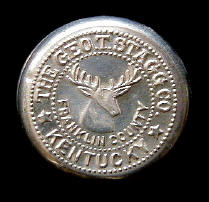 |
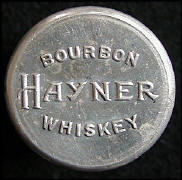 |
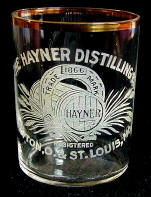 | |
| Figure 6 | Figure 7a | Figure 7b |
The second class of metal shots includes the one that most glass collectors are familiar with. These are two-part sliders that stand around 2-1/4” tall when open but collapse down to 1-1/2” [Figure 1]. It was one of these that first got me started down the shiny path, a once-in-a-lifetime find at a local antique show. The find turned out to be folly, however, because it advertises “Silver Dollar Rye’, the most common of all metal shots that appears with vulgar regularity every two weeks or so on eBay. Worse was yet to come, but not before I had acquired several different varieties of slider. The brand information always appears embossed in the base of slider so as be visible when viewed from the outside. This feature is a major clue as to its original use, although this did not become apparent until recently (see below). A second common slider features the trademark of the Geo Stagg Company of Franklin Co., Kentucky [Figure 6].
These can also be found relatively easily and at modest cost. The remaining examples are considerably less common. One was produced by The Hayner Distilling Co., the giant mail-order business that saturated the market with the most common of all pre-pro glasses [Figures 7a, b]. My favorite slider (probably because I don’t own one) features a banjo-playing African-American with an embossed label that reads “Old Man River Pure Rye Whiskey”. The maker of this brand is unknown, but one might guess that it has southern roots. There’s also one advertising Old Farm Whiskey, presumably from Abraham Overholt’s West Overton Distillery, PA [Figure 8]. Finally, there’s the slider labeled “PERFECTION IDEAL PROTECTION” [Figure 9]. The statement is sufficiently vague that it might advertise a whiskey, a medicinal, or even a household cleaning product: there’s no way to know for sure.
Most collectors assume that these sliders originated in pre-Prohibition times and the Hayner surely must since the company did not survive Carry Nation’s posthumous hatchet. I recently discovered that the Silver Dollar did not – indeed it’s probably not even of US origin - though a manufacturer’s stamp tells us it was made here. Sliders almost invariably surface in solitary fashion, but in very rare instances they appear married to a bottle. One such pairing is shown in the photo below; the slider sat atop a screw cap, providing a convenient alternative to taking a surreptitious swig when sampling the contents became necessary [Figure 10]. I obtained the pristine example shown here from Jay Hawkins and I’m most grateful to him for being willing to part with it.
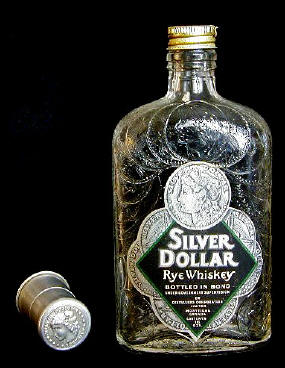 |
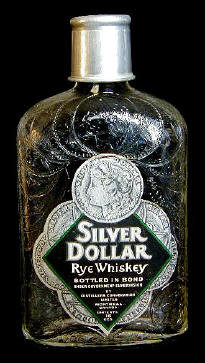 | |
| Figure 10 |
The bottle label tells a clear and intriguing story. Prior to the bottle
surfacing, it was generally assumed that the slider hailed from St Louis,
because Bob Snyder had reported the “Silver Dollar” brand as being recorded by
Louis Teuscher of Teuscher & Co. The company had a fairly spotty
representation in the city directories but they apparently operated from at
least 1892 until Prohibition. But the bottle label identifies the contents as
being Canadian, a product of Distillers Corporation Limited. This was the
company that marked the transition of the Bronfman family from mail-order
wholesalers and bootleggers to respected distillers. The name was surely
designed to ape the old and revered Distillers Company Limited of Scotland, a
company that the Canadian upstart hoped to emulate and eventually partnered
with. The Bronfman enterprise incorporated in Montreal in 1924, meaning that the
Silver Dollar slider must date to that time or later. Interestingly there are at
least two variants of this slider. The one that came with the bottle is
relatively uncommon and crude [Figure 11a], whereas my antique-show purchase is
much more common and the impression is crisper [Figure 11b]. Perhaps the latter is
more modern, its prevalence a reflection of the gaining popularity and
ascendancy of the new company during a time when official US production and
sales of whiskey had been reduced to a medicinal trickle.
[ Turn Back a Page ] [ Back to Random Shots Index ] [ Turn to Next Page ]